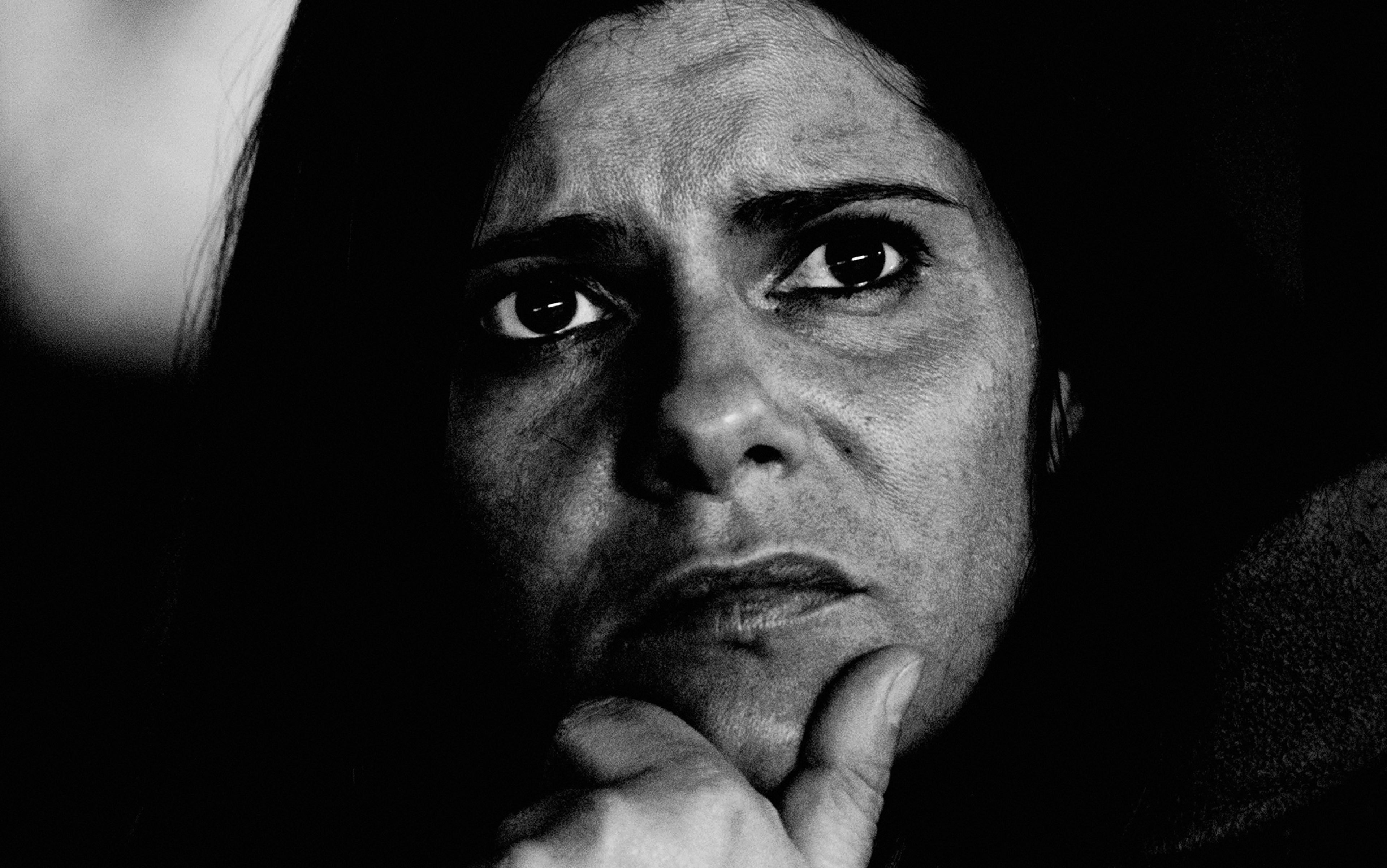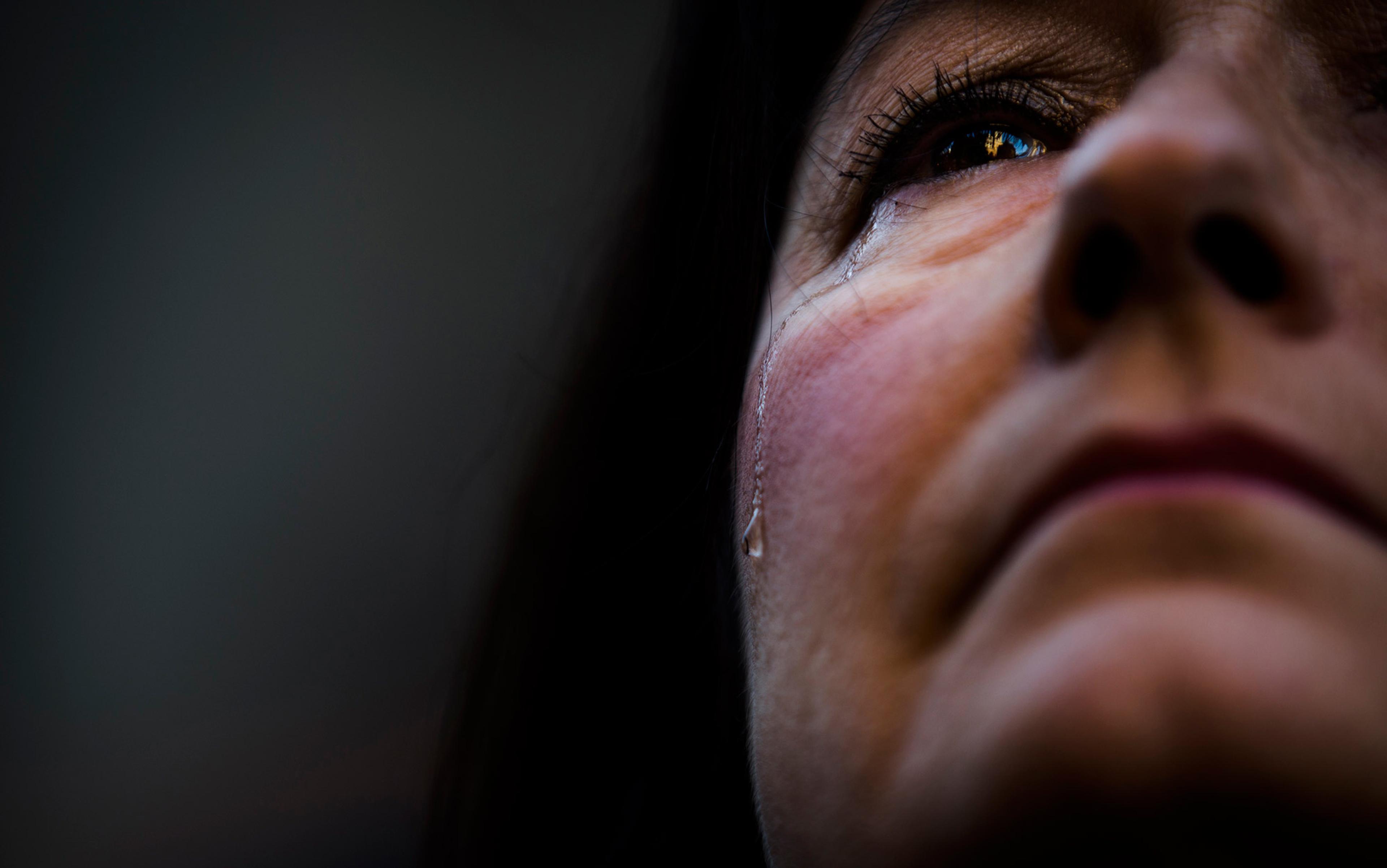The first time I saw Pixar’s movie Inside Out (2015), I was too entranced by its craftsmanship to realise that there was something odd, almost eerie, about its human characters. I was charmed by little Riley, the protagonist, with the chattering critters prancing around in her head. There’s Joy, a feisty version of Tinker Bell with cropped blue hair and indomitable optimism; Anger, a flaming-red stump with eyes like slits and fire bursting from his head; Sadness, a bespectacled blob; Fear, lanky and purple, with a bow tie and bushy eyebrows; and, finally, Disgust – green and chic, her long eyelashes fanning out of her face like miniature broomsticks.
From a control room in Riley’s mind, her personified emotions operate a switchboard with buttons and levers that cause the girl to smile, sulk or cry, or jolt her body into action – now it hugs, now it slumps, stomps, slams doors. It’s the kind of movie you’d expect Pixar to make – first-rate drama laced with wry humour and adorable characters. But with every prop made to tug your heartstrings, you’re bound to miss something: that behind her big and lovely eyes, little Riley is an automaton, a puppet pushed around by her emotions.
Were it mere make-believe, I wouldn’t quibble with the movie. But its fantastical veneer aside, Inside Out promotes a view that’s dominated psychology for more than 50 years: the idea that certain emotions are universal, innate and hardwired into our brains. Everyone, everywhere, apparently knows joy, sadness, anger, fear and disgust. We all think we can recognise these emotions in the faces of loved ones and strangers, friends and foes. The Basic Emotion Theory, as it is known, is not only taught at universities, it has trickled down into pop psychology books and radio shows and cocktail parties, pervading public consciousness as an incontrovertible fact. For a long time, few questioned it, and those who did were mocked at research gatherings or rejected by science journals.
The Basic Emotion Theory – also called the Universality Thesis by some of its critics – goes back to the 1960s, when the US psychologist Paul Ekman (who consulted on Inside Out) conducted studies with the Fore, an Indigenous society in Papua New Guinea. Ekman showed that the Fore could match photographs of faces with the emotional expressions they depicted – happy, sad, angry, disgusted, afraid or surprised – with a fairly high degree of correctness. Because his subjects had had little exposure to Western culture, Ekman claimed he’d found conclusive evidence for the existence of six basic, evolved, universally shared emotions. Each emotion, furthermore, came with a distinct, brain-bound affect programme. Triggered by an external stimulus, this underlying neural mechanism would set off a cascade of prebuilt responses, including physiological changes, facial expressions, behaviour tendencies and the subjective states we commonly call feelings.
The Universality Thesis appeals to our intuition that, somewhere deep down, we are all the same. Culture adds colour but, in small unguarded moments, our shared humanity leaks out: sadness wells up in the eyes, joy crinkles the lips. Over the past two decades, however, this view has come under attack from a small but growing group of iconoclast researchers. They argue that emotions are not hardwired responses that lurk in our brains (or guts, for that matter) waiting to be switched on by threats or opportunities. Instead, these researchers see emotions as emergent, highly situated ways of organising experience: exquisite acts of meaning-making, shaped by the complex interplay of nature and nurture. In this provocative new telling – let’s call it the Diversity Thesis – what we feel, how we feel it – perhaps even whether we feel it at all – depends not just on biology but also on context, including the language we use and the culture we come from.
Ekman viewed his rise to prominence as a victory of science over politics. In his telling, he took the side of evidence against a misguided and unfounded cultural relativism, whose proponents included three of the most influential anthropologists in the first half of the 20th century – Margaret Mead, Gregory Bateson and Ray Birdwhistell. All three supported the idea that our environment, not our genes, made us who we were; that differences between people stemmed not from nature, but nurture. Mead, in particular, argued passionately for the cultural basis of human behaviour and personality – a position she later defended as necessary at a time when acknowledged inborn differences could easily play into the hands of eugenics, social Darwinism and Nazi ideology.
However, Ekman believed that biology did not merely drive individual variation; it was also a source of innate commonality. According to Alan Fridlund, a social and clinical psychologist at the University of California Santa Barbara, Ekman’s theory of universal emotions found eager acceptance in the postwar decades, as the world scrambled for unity and peace. ‘The most popular commercial in television history had people from various cultures, in native garb, on a mountain top singing in unison: “I’d like to buy the world a Coke”,’ Fridlund told me. ‘There was the mood in the air that we’re all one people, one world, and we can all get along.’
Despite its promise to overcome prejudice, in the end the ‘one people, one world’ idea appears to have turned out the way racial colourblindness did: it imposed a limited anglophone model on human emotions, entrenching a Western perspective in the research, and obliterating differences from view. Now, armed with more sophisticated methods and new data, a growing number of scientists are shedding the blinders of universality and seeing, in its stead, a wondrous diversity of states and experiences that’s changing our understanding of what emotions really are.
What if subjects weren’t actually recognising the emotions but simply making educated guesses?
Fridlund was among the first to challenge the Basic Emotion view. As a recent PhD, he had been an Ekman acolyte; they’d even written papers together. Then he took a faculty position at the University of Pennsylvania and met W John Smith, who was studying birds. From Smith and others at Penn, Fridlund learned about recent advances in animal communication, which profoundly shook his confidence in the Universality Thesis. Previously, Fridlund told me, animals had been seen as automatons driven by reflexes, and ‘the Basic Emotion Theory that Ekman endorsed was stuck in that mould … Our emotions popped out because of these triggers we were all wired to have.’ But, over time, scientists realised that animals communicated in highly strategic and skilful ways, using a range of signals to negotiate their interactions with others – offspring, enemies, desired mates. ‘It blew my mind that animals were given much more credit by evolutionary biologists than the Basic Emotion theorists were giving humans.’
For decades after the original studies, Ekman’s Universality Thesis went largely unchallenged, spurring an era of vigorous research into human emotions that continues to this day. The first serious cracks began to appear in the early 1990s when the psychologists Andrew Ortony and James Russell had two highly influential critiques of Ekman’s findings published. Russell’s offered a detailed account of various methodological flaws, such as the forced-choice paradigm in which subjects match a face to an emotion word from a list of given options. What if, Russell asked, subjects weren’t actually recognising the emotions they picked out? What if they were simply making educated guesses?
The Basic Emotion Theory came under increasing scrutiny over the next decade but, according to the psychologist Carlos Crivelli, these were mostly ‘armchair debates’. The critical test for the universality of emotions would ultimately turn on studies of isolated Indigenous societies, where any observed cross-cultural similarities could not be due to Western influence. Surprisingly, no such studies had been conducted between 1976 and 2008. ‘At the end of the day, Ekman always said: “Well, I was there, you were not there”,’ Crivelli told me. So, when the anthropologist Sergio Jarillo de la Torre asked him to join a field trip to Papua New Guinea, the original site of Ekman’s studies, Crivelli saw an opportunity to put the ‘ground truth’ of universal emotions to the test.
Challenging an established theory was never going to be easy. ‘We had to do the perfect study,’ Crivelli said. ‘Way, way better than the previous ones.’ I asked him for details. He grinned conspiratorially. ‘I didn’t like adventure, let me tell you.’ When Crivelli speaks about his work, the words tumble out of him as if they’ve been there all along, on the tip of his tongue, waiting for their cue. He has no apparent need to stop and think or catch a breath and, when he needs to stress a point, he flings his arms about with gusto, as though exasperated by the poverty of speech.
Crivelli and Jarillo de la Torre first arrived in Papua New Guinea in 2013. For the 200-kilometre voyage between the mainland and their target – the Trobriand Islands – they hired a cargo boat to carry the gifts they had bought for the locals. (Trobrianders operate an exchange economy.) The cargo contained ‘everything you can imagine’ that could be had for under $3,000 – from pots and cutlery to soap, bandages, paracetamol, cloth rolls and, best of all for a place with no electricity, petrol lamps. On the shore, the boat’s contents spilled over an area metres wide: a junkyard of overpriced Chinese imports that, in this corner of the world, the alchemy of need turned to treasure.
Unlike previous studies that relied on translators, Crivelli learned the local language and immersed himself in life on the island. As much as possible, he wanted to keep Western culture from distorting his vision or sneaking biases into the research. Using a variety of rigorous testing and sampling procedures, Crivelli’s team conducted several studies (three published so far, and another under preparation) that cast serious doubts on the Universality Thesis.
Trobrianders ‘misread’ the fear face (eyes wide open, mouth gasping) as angry and threatening
In one experiment, published in 2016, just 7 per cent of Trobriander subjects correctly identified anger from posed photographs. The prototypical disgust face, in turn, was often seen as sad, angry or afraid. Only the smiling face was, by a slim majority of volunteers (58 per cent), matched to happiness. By contrast, a control group in Spain, shown the same photos, correctly identified the depicted emotions 93 per cent of the time, on average. In another study, Crivelli found that Trobrianders consistently ‘misread’ the paradigmatic fear face – eyes wide open, mouth gasping – deeming it angry and threatening. And when the standard forced-choice procedure was relaxed, about a fifth of the subjects insisted they didn’t know what emotion they were looking at when presented with a sad or a disgusted face. (In fact, in this study, the most common response to all but the happy face was not an emotion word at all but ‘gibulwa’, which roughly translates as a desire to avoid social interaction.)
Crivelli’s findings, paralleled by another team working in Africa, are hard to square with the Universality Thesis but not with the perspective I’ve been calling the Diversity Thesis. Known also as psychological constructionism, this alternative theory burst on to the scene in 2003, with a paper by Russell that, to this day, is among the most cited in affective science. Here, Russell laid out a new vision for the intricate ways that nature and nurture interact to produce the familiar yet enigmatic states we know as our emotions.
It starts with what he called ‘core affect’ – a general, undifferentiated sense of your body in the world, always present in the background. Think of it as a barometer that takes some very basic readings of your internal environment, then makes them available to consciousness in broad brushstrokes: are you feeling good or bad, lethargic or energised? According to Russell, core affect is our innate, shared emotional base, a sort of ‘minimal universality’. It could help explain the high cross-cultural overlap Ekman and others found in the identification of happiness, for example.
Yet core affect cannot account for the sheer variety of finely grained emotional states in which we find ourselves. Contentment, for example, is different from joy, and happiness runs the gamut from unbridled exuberance to quiet satisfaction. Awe strikes me as more complex still, the holding of fear and rapture in the same stunned breath at the contemplation of a greater force. More practically, with high-arousal negative states such as anger and fear, how do you get from those simple, undifferentiated sensations to actual anger, or flesh-and-blood fear – emotions we experience with vivid intensity, depth and detail?
According to the Diversity Thesis, this is where language and culture come in: they provide the particulars and furnish the definitions used to parse affect into emotion. We categorise our sensations to make them intelligible, and this act of conferring meaning to the low-res images our bodies churn out turns them into the bleeding, throbbing Technicolor experiences we recognise as our emotions. When you apply a label to your current state – say, ‘fear’ – you don’t merely invoke a symbol. A stupendous amount of fear-related data gets conjured up, too – anything from telltale signs to visual cues, surrounding context, probable causes, cultural meanings and expected consequences, all culled from past experiences of fear and stored into a mental model, or script. ‘To experience fear,’ writes Russell, ‘is to perceive a strong resemblance between one’s current state as one knows it and the mental script for fear.’
This doesn’t mean that emotions follow a predefined sequence, or that the new theory merely swaps a biological programme for one that’s learned. Rather, from a Diversity Thesis perspective, emotions emerge, much as a painting takes shape from a rough sketch: the random splotches of paint being joined into meaningful patterns, the artist daubing on colour, filling in detail, her brushstrokes getting progressively finer as her vision crystallises.
Emotions are assembled similarly, from core affect’s blurry outlines, as our brains layer on ‘emotion concepts’ of varying granularity and specificity. These concepts are pulled from the relevant mental script to fit and make sense of the situation at hand, constructing, in the process, an emotional episode. What we experience is shaped by a confluence of factors, just like a painting. Whether it ends up a Rothko or a Pollock or a Monet depends a lot on the artist’s palette, her knack for nuance, her upbringing and cultural influences. Those same things – our emotional palette, the early environment in which our brains encoded their emotion scripts, the wider culture that handed our parents the rulebooks, maps and templates for emotions: all these things profoundly shape our affective experience.
Culture doesn’t merely add local colour: it profoundly shapes the content of our emotional lives
The construction of emotions is also highly situated, so no two episodes of fear or anger or sadness need share the same components. If you feel afraid, your eyes might snap wide open, Russell argues – but only in cases when a wider field of vision can help you dodge a threat. Likewise, you might want to flee – or to sit and study for tomorrow’s exam. There could be, in fact, an infinite number of possible emotional states with no discrete signatures that let us cleanly separate them from other mental phenomena. According to Russell, nothing short of the whole of psychology can adequately encapsulate and explain every instance of human emotion. If this is true, it will no doubt frustrate scientists. But every other human being, I imagine, would find comfort in the knowledge that even our pettiest bouts of rage can hide some deep organismic intelligence; that, rather than the remnants of our bestial natures bursting out to torture or embarrass us, our emotions might be complex acts of meaning-making that show us who we are – tangled and sophisticated, even inscrutable to ourselves. Also: very, very different indeed.
The Diversity Thesis is still young and controversial, but evidence supporting its claims is fast growing. A formidable opposition to the Basic Emotion view has emerged in recent years, spearheaded by Lisa Feldman Barrett, a professor of psychology at Northeastern University in Boston, and her disciples. Kristen Lindquist at the University of North Carolina was an early member of Barrett’s lab back in the days when, as she told me, ‘people were saying: “This is crazy, this is heresy”.’ She, on the other hand, felt on the cusp of a revolution. ‘It felt like it’s time; we’re going to shift the tides.’
Lindquist’s initial research set out to demonstrate how brains construct emotions on the spot, by categorising core affect. In one study, published in 2008, some subjects were asked to tell a fear-related story, while others reflected on anger or a neutral topic. Lindquist found that, when the fear-primed participants listened to a rowdy mix of Holst and the Carmina Burana, designed to put them into a highly aroused, unpleasant state, they later displayed significantly more risk aversion – an implicit measure of fear – than the rest. It seemed that the concept of fear, made more accessible to these subjects’ minds, had attached itself to their free-floating negative affect and converted it into an actual experience of fear.
If emotions depend on concepts applied to internal states, then culture plays a key role in our emotional lives, by shaping the relevant mental scripts. In a 2018 study, a team of cultural psychologists, including Michael Boiger and Batja Mesquita at the University of Leuven, sampled shame experiences from hundreds of American, Japanese and Belgian subjects. The researchers fed the collected reams of data into a clustering algorithm to search for patterns. The algorithm spat out three distinct types of shame, one prevailing in each culture under study. Most Americans, for instance, felt ashamed when their personal flaws were revealed, a pattern consistent with a culture that places high importance on the individual. For the Japanese, on the other hand, situations that exposed one’s own failings not only did not cause shame, they were not taken very seriously at all. Instead, congruent with their interdependent cultural values, it was losing face in public that shamed the majority of Japanese subjects. (The Belgians exhibited a type of shame that fell somewhere in between the other two.) What these findings suggest is that culture doesn’t merely add local colour: it profoundly shapes the content of our emotional lives. Rather than qualifying as things we ‘have’, ‘experience’ or ‘feel’ – that is, static, given – emotions, argue Boiger and Mesquita, are dynamic, situated processes that help us navigate the social environments we inhabit.
Yulia Chentsova-Dutton grew up in an isolated town in the Caucasus Mountains in what was then the Soviet Union. At 16, she went on a people-to-people exchange to the United States as part of a diplomacy effort to warm up relations between the two countries after the Cold War. ‘One of the phrases people kept repeating when they would greet our delegation was: “After all, all children smile in the same language.” And I remember sitting there thinking, what are you talking about?’ She eventually realised that her American hosts were overeager to latch on to any similarities between themselves and their Soviet guests, because ‘they wanted to humanise these children of the enemy’.
Chentsova-Dutton went on to study cultural psychology, which offered the tools to probe her intuition that we are not, in fact, the same. She came up against a model of emotions that had changed little since the 1970s, that insisted ‘the lines are set by evolution, and culture colours a little bit on the surface’. But things are changing. Evolving methods over the past two decades have shown us that culture and biology interact in fundamental and intricate ways, and differences in emotions, previously undetected, are now coming into clear view.
These differences can be startling. ‘I ask my American participants how they’re feeling,’ she tells me. ‘I give them a list of emotions. They are done with that list in under a minute.’ With Chinese participants, the same task would take many minutes to complete. In Ghana, the experiment verged on ‘a disaster’. ‘My students would sit there with this one page of emotion terms for 30-40 minutes, just that page. And when I ask them what is happening, they would say: “Well, I understand all the words … but how am I supposed to know what I feel? … And as an emotion researcher and a cultural researcher, I was stunned because the fact that people know how they feel is never something I questioned.’
It’s common, in the West, to assume that, for people not to be aware of their internal states, something must have gone awry. We’ll likely suspect emotional suppression, and recommend a therapist to help them bring to light and face feelings they’ve bottled up. When I spoke with Boiger, I mentioned Chentsova-Dutton’s observations. He said they reminded him of a study he did with Japanese subjects in which he asked them how they felt. His question baffled some participants. It depends, they said: what would the other person do? ‘It didn’t make sense for them to just feel something for themselves … It’s much more of a dance, and the emotion is considered something that happens between two people.’
Americans report sadness while Chinese participants notice goosebumps, sweaty palms and muscle aches
In part, such findings can reflect differences in early socialisation practices. In many non-Western cultures, parents use a limited range of emotion words with their children, giving more weight to behaviours or bodily changes. Qi Wang, a professor of human development at Cornell University in New York, has observed that, when European American parents share memories with their kids, they tend to put the focus on the child’s own feelings and unique role in the situation. East-Asian American parents, by contrast, prefer to emphasise their children’s relatedness to others, using shared memories to bring up social norms and instil lessons for future behaviour. According to Wang, such conversations serve to transmit cultural values, guiding what gets internalised and what inhibited during development. By structuring our external environment in particular ways, our parents also scaffold our internal landscapes.
Since the landscapes researchers have so far explored turn out to be almost exclusively Western, the question then becomes: could our preoccupation with emotions reflect, in part, a cultural bias? ‘The contents of our mind at any given time produce a lot of different changes that we can potentially track and focus on,’ Chentsova-Dutton told me. To make sense of all those ‘blips’ that spike in our awareness, we carve up the subjective world into thoughts, feelings and perceptions, memories and daydreams, various aches and hurts. Remarkably, though, this separation doesn’t appear to exist in the brain; instead, researchers have found a significant overlap in the regions that process cognitive and affective states. Yet ‘in our popular imagination, there are these distinct slices and, in American culture, the slice that goes with emotions is privileged … And we’ve assumed that this privileged position at the foreground of our consciousness is just natural.’
Consider the so-called ‘Chinese somatisation’. Research in the 1980s found that depressed Chinese patients did not experience the illness in the ‘correct’ way. Instead of the expected psychological symptoms, they reported various aches, lack of sleep and exhaustion, leading scholars and doctors to puzzle over the missing emotions. But for Chentsova-Dutton, experiencing distress as somatic (ie, in the body, as distinct from the mind) could be part of a more general pattern of sense-making specific to Chinese culture. Initial support for this hypothesis can be found in recent studies that looked at subjects’ responses to sad films or music. American participants ‘report sadness and then nothing else, even if you ask about it’. Chinese participants, meanwhile, tend to notice a broad range of physiological changes, including goosebumps, sweaty palms, heart palpitations and muscle aches. ‘From a Western cultural perspective, we have called it somatisation to mark that this is an unusual pattern,’ Chentsova-Dutton told me. ‘But if you imagine a view from Chinese culture outward, you can also name it psychologisation.’
As I find out, I cannot, in fact, imagine this. It’s easier for me to picture Tinker Bell pressing switches in my head than to ponder, even hypothetically, the dimming of my emotional world. My thoughts and feelings are how I know myself, where I spend most of my time. Thinking of emotions not as the grounded truth of existence but as one mode of understanding – a self-preoccupation, a psychologisation – is impossible for me. And yet, I can’t help but appreciate the poetic justice of this impossibility. It is craftsmanship of a different order when nature and nurture collide, when biology and culture fuse together to create human diversity that trumps the imagination. Pixar’s is an amateur’s play.
In the end, I do manage a tiny glimpse from the Chinese view outward in one of Chentsova-Dutton’s most recent papers, which begins like this:
The term lexithymia describes a dimensional personality trait characterised, at the high end, by an extreme and potentially problematic tendency to think about one’s own emotional state and to describe these states to others … Lexithymic patients often do not respond well to, and may grow frustrated by, traditional somatotherapies (see ‘Somatotherapy with the Garrulous Patient’, Rolyat, 1980). Although local epidemiological studies suggest that high levels of lexithymia are relatively rare, there are some intriguing cultural variations. Mounting evidence suggests that lexithymia is much more common in so-called ‘WEIRD [Western, educated, industrialised, rich and democratic] people’, who tend to live in societies where an independent model of self-construal predominates … Rather than aiming to treat lexithymia, WEIRD societies have developed many indigenous approaches that encourage patients with various health problems to talk at great length about their feelings.
At first, I didn’t get that this was meant in jest. The vignette appeared in a scholarly article, so it caught me off guard. Before my critical filter could fire up, the message had slipped in: a flicker of understanding. And, as I began to grasp my sense of Western superiority, I felt a new, uncomfortable feeling – one I had the urge to talk about at great length.
To read more about the history of emotions, visit Psyche, a digital magazine from Aeon that illuminates the human condition through psychology, philosophy and the arts.






